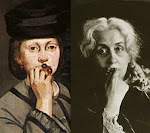 Lately, my mind keeps returning to a painting entitled La Cuisinière by Willem Van Mieris – Leyde (Leiden), 1715. (Here I have only posted a detail).
Lately, my mind keeps returning to a painting entitled La Cuisinière by Willem Van Mieris – Leyde (Leiden), 1715. (Here I have only posted a detail).Certainly it is far from the most astonishing work in the Louvre. In fact, the second time I returned to see it I almost didn’t find it again – it was so small and ordinary in its crowded room not so far from Rubens’s Marie de Médicis Cycle. There are, to me, tragedies in its display, especially that it is under glass, and under spotty glass at that, so that the surface and texture of the oil paint, as well as its application, are all bits of an unsolved mystery.
Willem van Mieris and his brother Jan van Mieris were the sons of Frans van Mieris, Sr. – all were painters in the 17th century; Willem into the 18th. Jan, despite being only two years older than Willem died in 1690 at the age of 30. He had apparently been sickly the whole of his life.
25 years after the death of his older brother, Willem painted La Cuisinière. When phrased that way it sounds sufficiently causal but I mean that only slightly.
I keep trying to come to terms with what I find so terrifying about the carrots and turnips and the head of lettuce/cabbage in the painting. I have posted the best picture I could take but even this image cannot convey the tinyness and sharpness of detail that attends these vegetables. In front of the painting you can see every single stitch in the blanket on which the carrots lay, all the wiry and wayward hair-roots waving out from the bodies of the tubers – they are sharp and crisp but seem animated in the way that one sees in a microscope sometimes when a fiber is taking on moisture and uncoiling. And every tag and indention of the tuber-skin seems embedded with soil. Glistening and entwined like snakes mating in a pit, but also fleshy like the thighs of women, some splayed, some crossing – the whole play of seduction and repulsion and spentness informs these carrots.
But what is horrifying are not these sexual or bodily readings-in but just the sheer animation of these carrots. It would be less frightening if I could attribute something like sexual desire to them, because that is a category of human understanding. But what could plant-desire even be like?
I remember reading something in Schopenhauer about plant locomotion – that a plant’s proto-will could be identified in its movement towards water. Darwin’s last work was on The Power of Movement in Plants. Popular culture gives us atrocities like Little Shop of Horrors or Roald Dahl’s fantasies of plants that scream when cut or plucked. People play music for their plants and talk to them, reporting that their plants respond favorably. But in attributing willing and mating, singing and screaming and responding to music or speaking we make plants into us – attaching culture to the most primitive forms of reproduction and response and motion. Like 18th century Montpellier physicians with their electrodes and sentimental hunks of flesh.
What is frightening about the vegetables of Willem van Mieris is that he gives us carrots and cabbages suggestive enough to read into, but then somehow manages to take it all away, leaving the viewer with the wholly-unknowable otherness of plants as types of things that cannot be thought into. The inclusion of erotic or sensual forms – of wounds and hairs and thighs – only highlights the uncanny emptiness of these projections of our consciousness into and onto things in the world, and the cold impenetrability of matter.


1 comment:
I do know that carrots are root-vegetables and not tubers, but "tuber" is such a better word.
Post a Comment